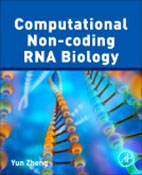Last edition Elsevier Computational Non-coding RNA Biology is a resource for the computation of non-coding RNAs. The book covers computational methods for the identification and quantification of non-coding RNAs, including miRNAs, tasiRNAs, phasiRNAs, lariat originated circRNAs and back-spliced circRNAs, the identification of miRNA/siRNA targets, and the identification of mutations and editing sites in miRNAs. The book introduces basic ideas of computational methods, along with their detailed computational steps, a critical component in the development of high throughput sequencing technologies for identifying different classes of non-coding RNAs and predicting the possible functions of these molecules. Finding, quantifying, and visualizing non-coding RNAs from high throughput sequencing datasets at high volume is complex. Therefore, it is usually possible for biologists to complete all of the necessary steps for analysis.
Last Edition
ISBN 13: 9780128143650
Imprint: Academic Press
Language: English
Authors: Yun Zheng
Pub Date: 09/2018
Pages: 320
Illus: Illustrated
Weight: 670.000 grams
Size: 191 X 235 mm
Product Type: Softcover
| List Price |
| grn 4812 |
| $ 163,13 |
| to order |
- • Presents a comprehensive resource of computational methods for the identification and quantification of non-coding RNAs
- • Introduces 23 practical computational pipelines for various topics of non-coding RNAs
- • Provides a guide to assist biologists and other researchers dealing with complex datasets
- • Introduces basic computational methods and provides guidelines for their replication by researchers
- • Offers a solution to researchers approaching large and complex sequencing datasets
- Yun Zheng, Kunming University of Science and Technology, China
- PART 1 - BACKGROUND
- Chapter 1 - Introductions
- 1.1 Introduction to di?erent types of non-coding RNAs 1.2 Introduction to high throughput sequencing technologies 1.3 Brief introduction of software used in the book 1.4 The file formats of sequences and sequencing profiles 1.5 The file formats for gene annotations 1.6 Reference
- PART 2 - SMALL NCRNAS
- Chapter 2 - Identification of microRNAs
- 2.1 A schematic view of the computational analysis for small RNA 2.2 The biological background for identifying miRNAs 2.3 A general pipeline for processing small RNA sequencing profiles 2.4 The pipeline for calculating length distributions of sRNAs 2.5 Calculating the abundances of miRNAs in sRNA-seq profiles 2.6 Identifying precursors of conserved miRNAs 2.7 Identifying novel pre-miRNAs from sRNA-seq 2.8 Visualizing the expression levels of miRNAs in sRNA-seq profiles 2.9 Analysis of the expression patterns of miRNAs 2.10 Analysis of miRNAs and their expression patterns 2.11 Summary
- Chapter 3 - Identification of TAS and PHAS
- 3.1 Introduction of secondary small RNAs in plants 3.2 Identification of TAS3 in plants 3.3 Visualizing the siRNAs originated from TAS loci 3.4 Identification of PHAS in plants using sRNA-seq profiles 3.5 Analysis of results of identified TAS and PHAS loci3.6 Summary
- Chapter 4 - Identification of editing and mutation sites in miRNAs
- 4.1 Introduction of editing and mutation sites in miRNAs 4.2 Identifying mutation and editing sites in miRNAs 4.3 Detailed commands to fulfill the MiRME pipeline 4.4 Auxiliary tools in the MiRME package 4.5 Integrating genome sequencing profiles to di?erentiate editing and mutations 4.6 Analysis of the MiRME results
- PART 3 - MIRNA TARGETS
- Chapter 5 - Identifying animal miRNA targets
- 5.1 The important determinants for miRNA target recognition in animals 5.2 Sequencing based methods for identifying animal miRNA targets 5.3 Traditional miRNA target prediction methods in animals 5.4 Identifying animal miRNA targets using PAR-CLIP seq 5.5 Analysis of identified miRNA targets 5.6 Summary
- Chapter 6 - Identifying plant miRNA targets
- 6.1 The miRNA and siRNA targets recognition in plants 6.2 Traditional miRNA target prediction method in plants 6.3 Plant miRNA target prediction using degradome sequencing profiles 6.4 Analysis of the obtained results of the SeqTar pipeline 6.5 Summary
- PART 4 - LONG NCRNAS
- Chapter 7 - Identification of long non-coding RNAs
- 7.1 A schematic view of the computational analysis for sequencing profiles of long RNAs 7.2 A brief introduction of long non-coding RNAs 7.3 Identification and quantification of lncRNAs from RNA-seq profiles 7.4 Computational analysis of structures of lncRNAs 7.5 Analyzing coding capacities of lncRNAs 7.6 Analysis of the identified lncRNA candidates 7.7 Summary
- Chapter 8 - Identification of lariat RNAs
- 8.1 Brief introduction to splicing and lariat RNAs 8.2 Identification and quantification of lariat RNAs from RNA-seq profiles 8.3 Identification of intron branch points 8.4 Lariat RNAs inhibits microRNA biogenesis 8.5 Summary
- Chapter 9 - Identification of circular RNAs
- 9.1 Brief introduction to back-splicing and circular RNAs 9.2 Identifying circRNAs from RNA-seq profiles 9.3 Calculating the expression levels of circRNAs 9.4 Analyzing the repeat elements in introns around circRNAs 9.5 Identifying miRNA binding sites on circRNAs 9.6 Summary
- Chapter A - A usage guide of web-based ncRNA resources
- A.1 A usage guide of web-based ncRNA resources A.2 UCSC Genome Browser A.3 Visualization of ncRNAs with Integrated Genomics Viewer
- Chapter B Abbreviations and acronyms
- B.1 Abbreviations and acronyms
- To order a book, you need to send a phone number for a callback. Then specify:
- 1. Correct spelling of the first name, last name, as indicated in the passport or other document proving the identity. (Data is required upon receipt of the order)
- 2. City of delivery
- 3. Nova Poshta office number or desired delivery address.
- The prices on the site do not include the cost of Nova Poshta services.
- When prepaying for the Master Card, the supplier pays the order forwarding.
- Delivery is carried out anywhere in Ukraine.
- Delivery time 1-2 days, if the book is available and 3-4 weeks, if it is necessary to order from the publisher.




